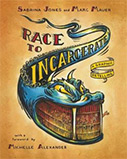Race to Incarcerate: A Graphic Retelling
 Author: Sabrina Jones and Marc Mauer
Author: Sabrina Jones and Marc Mauer
Publisher: New York: The New Press, 2013. 128 p.
Reviewer: Bonita M. Veysey and Kito Davison | September 2013
In her foreword to this book, Michelle Alexander makes the following observation, “I realize that I rarely shared the book [Race to Incarcerate] with young people. …The problem was that Race to Incarcerate was not designed for young people. …I never felt satisfied with what I had to offer and wished that someone would write a book that would be engaging and accessible to young readers and people of all walks of life. …I could not be more thrilled that the book that fueled so much of my own civil rights work and advocacy is now available in a graphic form designed for the very generation that, I am confident, will build and lead the movement to end mass incarceration in America” (p. vii-viii).
This book is indeed designed like a graphic novel. It takes about two to three hours to read and virtually each and every frame conveys a fact. The book does not follow a traditional story line, but rather is a collection of critical cartoons illustrating related facts. When I (Veysey) first read this book, I worried about the medium. I thought that undergrad students would find this insulting; as if I did not trust them to be able to read and understand the original. However, I am old relative to the target audience for this book, and was a little uncertain about my reactions. Therefore, I asked a graduating criminal justice major to give the book a read and give me his impressions. My young colleague wrote the following:
Race to Incarcerate: A Graphic Retelling is the ultimate book pertaining to the criminal justice arena. Although the comic book “feel” partially takes away from the intended goal, it is strategically and powerfully written. Anyone who reads this can see that “Policy and Profit” is the topic, and if you cannot see it, then you probably believe in profit over people. Jones and Mauer make it unequivocally clear that when crime became politicized, mass incarceration was the result. Race to Incarcerate should be a requirement for anyone who is interested or involved with social, justice and/or policy issues; that is, “people” issues. Read it over and over. The more you read Race to Incarcerate, the more you’ll see it.”
After reading Kito Davison’s comments and talking to him more about his experience with the book, I read it again with a different eye. While it lacks citations compared to more traditional academic books, I think it does present valid information in a convincing manner. Moreover, simple statements and pictures leave much to the imagination. If students and others use this as an accessible means to learn about mass incarceration, the book achieves its goals. If the book encourages students to explore these topics in more detail, it far exceeds its goals. This is a book that can be read and viewed over and over — each time getting something a little different from its pages. I agree with Professor Alexander that this is a book for a new generation of students that can set the stage for the elimination of mass incarceration.
Bonita M. Veysey, Ph.D., Rutgers University, School of Criminal Justice and Kito Davison, Rutgers University, School of Public Affairs and Administration


